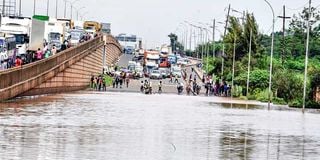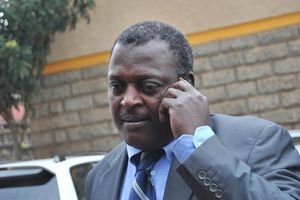
Residents stare down at a flooded section of the Thika Superhighway at the Kahawa Sukari exit on May 1, 2024.
The floods in Kenya have entered a catastrophic phase, where they threaten to destroy infrastructure and parts of our cities. The only people who are nonchalant about the crisis are the government officials whom we rely on to rescue us.
One presidential adviser, known for a gigantic ego, told hurting people clamouring for the government’s attention that the government is not an “agony aunt”—perhaps the worst wisecrack of a generally insensitive administration so far.
At the time of writing, 72 hours of particularly heavy downpour were in the forecast with 188 people already dead and 90 others missing, according to the Interior ministry. Nationally, 190,942 were displaced, 147,000 of them in Nairobi alone. All this will get worse over the weekend before, hopefully, the rains begin to taper off.
Surprisingly, the government is still unconvinced that this is a national disaster.
While there is extensive flooding outside Nairobi, especially in the Maasai Mara, where tented camps are under water and tourists being evacuated by helicopter, as well as in Mai Mahiu, where a flooded tunnel burst, causing mudslides in which 52 people were killed, the capital city has taken the most direct hit. There were floods in Marsabit, Turkana, Kisumu, Kericho, Narok, Mwea in Kirinyaga and Garissa. With the soils already waterlogged, places with steep slopes and a history of landslides, such as Murang’a, are at significant risk.
Flood disaster
Very heavy rainfall was forecast for Nairobi yesterday with parts of Kasarani, Embakasi, Roysambu and Westlands expected to get more than 100mm of rain. Less than 30 minutes of a heavy downpour left many parts of the city, including major roads, under water.
This is the worst flood disaster in recent memory and there is room for things to get a lot worse. The biggest danger is in Nairobi, where careless development has left many parts without proper drainage. The county government has been accused of approving buildings which block rivers.
Slums and informal settlements do not have any services—no clean water, no sewer systems and no organised methods of dealing with storm water. Some are in low-lying areas, some sections are on steep slopes. Low-lying areas become lakes during heavy downpour while the steep slopes are always in danger of being swept clean by flash floods.
But even in areas with proper systems, the drainage systems are getting overwhelmed; the current severity of rainfall was probably not anticipated in the design and construction of drains. In any case, the city does not provide sewerage in many parts, with the job being left to developers who could cut corners.
The coordination of disaster preparedness and response in Kenya is at the embryonic stage. The Meteorological Department still issues regular, dry and mostly accurate forecasts and sends alerts on social media. There is a National Disaster Management Unit in existence, which, helpfully, publishes its mission on its rather dated website and social media property.
Create awareness
So, what do we do? I believe we should first create awareness in the bureaucracy, all the way to the senior levels, that it is the sacred duty of the government to preserve the life of its people; to come to their aid when they are in distress. If you are buried in a mudslide, all the most complex economic models are of no use to you. On the flipside of the coin, voters should teach insensitive governments and leaders a lesson in humility at the election.
Secondly, awareness should be created, first in the government, then to the people, that climate emergencies are the new normal: There will be floods, there will be extreme droughts, there will be storms, strong winds, fires and coastal flooding.
Then there should be an upgrade in the emergency preparedness and response system with emphasis on and investment in coordination between the various agencies. There should be a fulltime, professional well-resourced disaster response coordination authority with the power to mobilise military, law enforcement and national and county government resources and deploy them appropriately in times of need.
There should be significant investment in communications, so that the authorities have 24-hour access to every citizen—not just on the free social media platforms but through text, radio, TV and telephone calls. Some countries have systems of alerting citizens to danger, be it through the ringing of church bells or air raid sirens, and this is something that should be tested here, especially in the cities. Kenyans are spoilt by the fact that we are not used to extreme weather and other emergencies. These are coming, and it makes sense to be prepared.
Lastly, the infrastructure must be upgraded. Most of the Chinese roads do not have drainage. It makes sense to recall the contractors and have them understand that without a proper and adequate drainage system, a road is incomplete. And if they received instructions to build the road without drainage, then the issuer of those instructions should be identified so that they can be processed appropriately.
The biggest obstacle remains corruption. Officials are paid to look the other way so that contractors can cut corners. A disaster, to some people, means easy money. And there could be powerful people who think all this disaster business is a waste of time and money. That is real risk.
Mr Mathiu, a former Editor-in-Chief of Nation Media Group, is a media consultant at Steward-Africa. [email protected].













